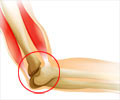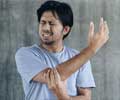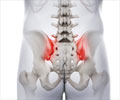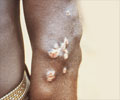- Joint pain - (http://www.mayoclinic.com/health/joint-pain/MY00187/DSECTION=causes)
- Richie AM, Francis ML. Diagnostic Approach to Polyarticular Joint Pain. Am Fam Physician 2003;68:1151-60.
About
Joint pain and stiffness are common in individuals of all age groups. The causes however vary among individuals of different ages. For example, a child may complain of pain due to a developmental malformation. A young adult often suffers from joint pain due to trauma, whereas an elderly person may suffer from degeneration of the joints or
Joints are the region where adjacent bones meet. The ends of the bones are usually covered with cartilage and lined by synovial tissue. The joints are bathed in fluid to reduce the friction. They are surrounded by ligaments to hold the bones together.
Inflammation can affect joints and result in pain.
- Inflammation of the joint per se is called arthritis.
- Inflammation of the tissue lining the joint (synovial tissue) is called synovitis.
- Inflammation of a tendon is called tendonitis. The tendon is the end of the muscle that is inserted into the bone. It is often present close to a joint.
- Inflammation of the bursae is called bursitis. A bursa is a fluid-filled sac often positioned between tendons. It ensures smooth movement of the tendons over each other.
Some clues that may point out to the origin of pain in a joint are:
- Pain in a weight-bearing joint like the knee in an elderly individual may be due to osteoarthritis.
- Pain in the big toe is often due to gout.
- Joint pain with skin lesions may be due to an autoimmune disease like psoriasis.
- Symmetrical joint pain with morning stiffness may be due to rheumatoid arthritis.
- Pain that migrates from one joint to another symmetrically on both sides of the body may be due to rheumatic fever.
Some conditions affect a single joint, whereas others result in pain and stiffness of multiple joints. Common causes of joint pain and stiffness are listed below:
Autoimmune Conditions: Autoimmune diseases are conditions in which the body produces antibodies against itself. Rheumatoid arthritis, reactive arthritis and lupus result in antibodies against components of the joint, resulting in pain and stiffness. In these cases, multiple joints are usually involved. The patient often complains of stiffness of joints in the morning, which reduces as the day progresses. Rheumatoid arthritis usually affects joints symmetrically on both sides of the body. Ankylosing spondylitis affects the vertebral joints, resulting in back pain. Patients with psoriatic arthritis show the presence of skin lesions and nail changes of psoriasis.
Osteoarthritis: Osteoarthritis is a common form of arthritis that affects joints due to wear and tear. It usually affects the weight-bearing joints like the hips, knees, ankles and spine. The patient is usually an elderly individual and complains of pain, stiffness and restriction of movement of the joint. In some cases, joint swelling may be present. Small bony nodes may be felt below the skin.
Chondromalacia Patellae: This condition results in aching pains in the knees during and after activities, or following prolonged sitting. The pain is located around the knee cap and is accompanied by symptoms of catching, cracking and giving-way sensation.
Gout: Gout is a condition where the uric acid levels in the blood rise. The joints of the big toe are typically involved, though other joints may also be affected. The big toe becomes painful, red and swollen. A blood test can detect excessive uric acid levels in the blood. Gout also occurs as a side effect of drugs like some of those used for high blood pressure.
Infections: Certain infections are associated with painful joints. Some of the infections that produce classic joint symptoms are:
- Rheumatic fever: Rheumatic fever occurs following an infection with bacteria from the streptococcal family. The ankles, knee, elbows and wrists are commonly affected. The joints tend to be painful, red, hot and swollen. The patient has joint pains that move symmetrically from one joint to the other.
- Chikungunya: Chikungunya is a viral disease that is spread through the bite of an infected mosquito. The joint pain tends to be severe, but usually reduces within a few weeks. In rare cases, it may last for several months or years. The initial joint pain is usually accompanied by fever.
- Osteomyelitis and Septic Arthritis: Bacterial infection of the bones results in osteomyelitis, whereas infection of the joints is referred to as septic arthritis. Infection of the joints causes the joints to be painful, hot and swollen and may result in joint destruction. Septic arthritis usually affects a single joint. Fever is often present.
- Other infections: Other infections like Epstein-Barr viral infection, hepatitis, influenza, Lyme disease, measles, mumps, parvovirus, German measles and chicken pox may be associated with non-specific joint pain.
Injury: Injury to the joint is a common cause of joint pain. At times, the end of the bone may be fractured. Other injuries include trauma to the cartilage within the joint, synovium or ligaments. The joint appears painful, red and swollen. A history of injury is also often obtained from these patients. In other cases, the patient may give a history of unusual exertion or overuse of a joint, resulting in strains or sprains of the ligaments surrounding the joint. Trauma usually affects a single joint. In some cases, trauma may result in dislocation of a joint, resulting in severe pain while attempting movement of the joints.
Cancer: Cancer of the bones can spread to the neighboring joint resulting in pain. The cancer may have originated from the bones or spread to the bones from another site. A hard swelling may be obvious in these cases.
Growing Pains: A child may experience pain in the joints as a part of the growing process. This pain awakens the child at night and usually lasts for 30 to 60 minutes. It normally does not occur in the daytime, and therefore the child’s activities are usually not affected.
Fibromyalgia: Fibromyalgia is a condition of unknown origin where the patient complains of multiple tender points all over the body including joints, muscles and tendons. The pain may get worse with stress or activity. The patient may be depressed or complain of problems with sleeping.
Frequently Asked Questions (FAQs)
1. Which doctor should I visit in case I suffer from joint pain?
You should visit an
2. What are the common causes of knee pain?
Common causes of knee pain include arthritis including osteoarthritis, knee injuries that result in cartilage tears, ligament injuries, or stains or sprains, inflammation of bursae, and dislocation of the knee cap.










